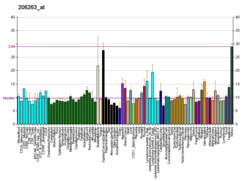FMO4
Dimethylaniline monooxygenase [N-oxide-forming] 4 is an enzyme that in humans is encoded by the FMO4 gene.[5][6]
Function
Metabolic N-oxidation of the diet-derived amino-trimethylamine (TMA) is mediated by flavin-containing monooxygenase and is subject to an inherited FMO3 polymorphism in man resulting in a small subpopulation with reduced TMA N-oxidation capacity resulting in fish odor syndrome Trimethylaminuria. Three forms of the enzyme, FMO1 found in fetal liver, FMO2 found in adult liver, and FMO3 are encoded by genes clustered in the 1q23-q25 region. Flavin-containing monooxygenases are NADPH-dependent flavoenzymes that catalyzes the oxidation of soft nucleophilic heteroatom centers in drugs, pesticides, and xenobiotics.[6]
References
- 1 2 3 GRCh38: Ensembl release 89: ENSG00000076258 - Ensembl, May 2017
- 1 2 3 GRCm38: Ensembl release 89: ENSMUSG00000026692 - Ensembl, May 2017
- ↑ "Human PubMed Reference:".
- ↑ "Mouse PubMed Reference:".
- ↑ Lawton MP, Cashman JR, Cresteil T, Dolphin CT, Elfarra AA, Hines RN, Hodgson E, Kimura T, Ozols J, Phillips IR (Mar 1994). "A nomenclature for the mammalian flavin-containing monooxygenase gene family based on amino acid sequence identities". Arch Biochem Biophys. 308 (1): 254–7. doi:10.1006/abbi.1994.1035. PMID 8311461.
- 1 2 "Entrez Gene: FMO4 flavin containing monooxygenase 4".
Further reading
- Hines RN, Cashman JR, Philpot RM, Williams DE, Ziegler DM (1994). "The mammalian flavin-containing monooxygenases: molecular characterization and regulation of expression". Toxicol. Appl. Pharmacol. 125 (1): 1–6. doi:10.1006/taap.1994.1042. PMID 8128486.
- Dolphin CT, Shephard EA, Povey S, Smith RL, Phillips IR (1992). "Cloning, primary sequence and chromosomal localization of human FMO2, a new member of the flavin-containing mono-oxygenase family". Biochem. J. 287 ( Pt 1) (Pt 1): 261–7. PMC 1133153. PMID 1417778.
- Phillips IR, Dolphin CT, Clair P, Hadley MR, Hutt AJ, McCombie RR, Smith RL, Shephard EA (1995). "The molecular biology of the flavin-containing monooxygenases of man". Chem. Biol. Interact. 96 (1): 17–32. doi:10.1016/0009-2797(94)03580-2. PMID 7720101.
- Itagaki K, Carver GT, Philpot RM (1996). "Expression and characterization of a modified flavin-containing monooxygenase 4 from humans". J. Biol. Chem. 271 (33): 20102–7. doi:10.1074/jbc.271.33.20102. PMID 8702731.
- Janmohamed A, Dolphin CT, Phillips IR, Shephard EA (2001). "Quantification and cellular localization of expression in human skin of genes encoding flavin-containing monooxygenases and cytochromes P450". Biochem. Pharmacol. 62 (6): 777–86. doi:10.1016/S0006-2952(01)00718-3. PMID 11551524.
- Furnes B, Feng J, Sommer SS, Schlenk D (2003). "Identification of novel variants of the flavin-containing monooxygenase gene family in African Americans". Drug Metab. Dispos. 31 (2): 187–93. doi:10.1124/dmd.31.2.187. PMID 12527699.
This article is issued from
Wikipedia.
The text is licensed under Creative Commons - Attribution - Sharealike.
Additional terms may apply for the media files.




